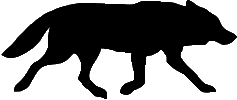Biology
Predation
The wolf is an opportunistic carnivore, who feeds on both actively hunted preys and carcasses of dead animals. The wolf’s hunting techniques are highlighted by the shape of the skull and above all by its teeth: incisors and canines are the first tool wolves use to stop the prey, producing a deep laceration. The particularly developed feral teeth, i.e. the fourth upper premolar and the first lower molar are used to cut portions of meat. Even the relatively short intestine is an adaptation for the carnivorous diet that includes foods easy to digest.
Five phases are identified in the wolf hunting behaviour. The first one includes the localization of the prey, which occurs through occasional encounters or active research using above all the sense of smell. Then there is the approach phase, in which wolves are very excited but still do not start the actual hunting action.
Then the meeting takes place, during which wolves and their prey see each other for the first time and compare their forces. The prey at this point has three possibilities: to stay still, to get closer to the wolves or to run away. If the prey does not escape, wolves, after having tested it, can let it go, otherwise they get into the attack phase. If it is a small prey the attack is sudden. In case of larger prey a chasing phase begins during which it seems that the wolves test the prey to find its weak point until it is immobilized.
Even though the emphasis has always been made very much on the hunting of the pack, the most effective hunting however occurs probably in couple, because the couple remains tied for a long time, and therefore it is more efficient for a consolidated experience, and because the other members of the pack , generally the young ones, being in the pack for just a limited period before leaving for dispersal are therefore inexperienced themselves; and finally the food must be divided among several individuals rather than only two.
There is surely a certain degree of strategic cooperation between individuals, although not all scholars agree on the degree of randomness in the observed behaviours.
History
Survival of the wolf at landfills
………we are writing it………
Curiosity
Trophic cascade: the example of Yellowstone
The story of the Yellowstone National Park since its creation represents an example on how the loss or introduction of a key species as important as the wolf can cause significant changes in the vegetation and biodiversity of an ecosystem.
In 1871 the Yellowstone Park was created, within which not all species were protected, so that wolves and pumas had been intentionally eliminated. Deer were allowed to reproduce freely but already by the end of the 1930s their number had grown so much as to cause enormous damage to the vegetation, so that their number had to be kept under control until 1967, when following the pressure of public opinion the practice of eliminating them was abandoned. The number of deer began to grow again, to such an extent that in the coldest winters the deer was starving en masse.
So the decision was made then to reintroduce the natural predator of the species: the wolf. Between 1995 and 1996, 31 wolves were released and a detailed and exciting study started on the interactions that would emerge. Wolves began to prey on the deer; to escape from wolves, the deer started to move and to use different areas avoiding the big pressure on some woodland formations and exploiting different environments. Wolves began to prey also on the bison and the lower pressure on the vegetation of these herbivores (deer and bison) allowed the growth of some plant species where the continuous grazing impeded it before. The growth of trees allowed consequently the nesting of many bird species…
The reintroduction of the predator had thus triggered a positive “trophic cascade” on the entire ecosystem, turning the Yellowstone Park into an open-air laboratory. The study of this phenomenon is still ongoing because it has been discovered that many other variables such as occasional floods, temperatures, geology and land morphology also contribute to shape the environment and to set the interaction between species; but, of course, the presence of the wolf has brought positive changes on biodiversity and on the natural regulation of the animal and plant populations of Yellowstone.
The term “trophic cascade” refers to the significant changes in vegetation and biodiversity caused by the loss or introduction of a “keystone species”.
A “keystone species” is a species that has a fundamental influence (related to the number of individuals or to the biomass) on the organization of the biological community in which it lives. The loss of a keystone species could have an enormous repercussion on the entire community.
